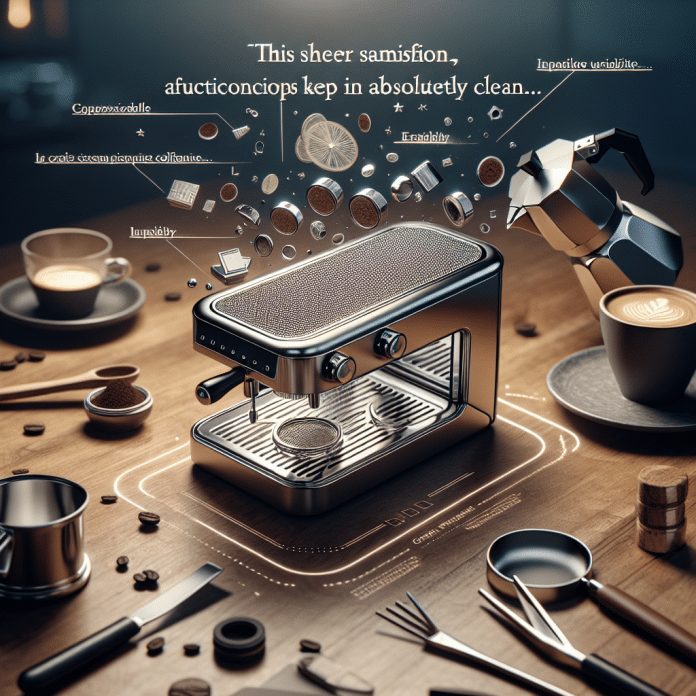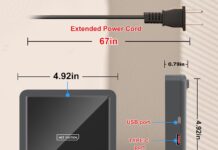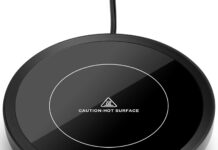Are you tired of the mess and hassle that comes with brewing coffee? Look no further than Coffee Knock Boxes for Cleanup While Brewing. These innovative tools are designed to make your coffee brewing experience clean and efficient. With their sturdy construction and convenient design, these knock boxes allow you to easily discard coffee grounds while brewing, saving you time and effort. Say goodbye to messy countertops and hello to a seamless brewing process with Coffee Knock Boxes for Cleanup While Brewing.
What is a Coffee Knock Box?
Introduction to Coffee Knock Boxes
If you’re an avid coffee lover and enjoy brewing your own coffee at home, a coffee knock box is a must-have accessory. A coffee knock box, also known as a coffee puck bin or a coffee grounds bin, is a specialized container designed to collect and dispose of used coffee grounds. It provides a convenient and hygienic solution for removing the spent coffee grounds from your portafilter or brewing device.
Purpose of a Coffee Knock Box
The primary purpose of a coffee knock box is to make the cleanup process easier and more efficient while brewing coffee. Instead of having to tap the portafilter against the edge of your trash can or make a mess by trying to scrape the grounds into the sink, a coffee knock box provides a dedicated space to knock out the used coffee puck. By eliminating the need for manual tapping or messy disposal methods, a coffee knock box helps maintain cleanliness, hygiene, and organization in your coffee brewing routine.
Why Use a Coffee Knock Box?
Preventing Mess and Contamination
Using a coffee knock box ensures that the used coffee grounds are contained in a dedicated receptacle instead of scattering them all over your countertop, sink, or trash can. This prevents messy cleanup and reduces the chance of contaminating other surfaces or utensils with coffee residue. The sturdy construction and design of a coffee knock box also prevent any leakage or spillage, keeping your brewing area neat and tidy.
Saving Time and Effort
Removing coffee grounds from your brewing device can be a time-consuming and labor-intensive task. Without a coffee knock box, you may need to manually scrape the grounds, resulting in a longer cleanup process. By simply knocking the portafilter or brewing device against the knock bar of a coffee knock box, you can quickly and effortlessly dislodge the spent coffee puck. This saves valuable time and effort, allowing you to focus on enjoying your freshly brewed coffee.
Compatibility with Various Brewing Methods
One of the great advantages of coffee knock boxes is their versatility and compatibility with different brewing methods. Whether you’re an espresso enthusiast, a French press lover, or prefer pour-over drippers, an Aeropress, or a Moka pot, a coffee knock box can accommodate the used coffee grounds from any of these brewing methods. This makes it a convenient tool for coffee enthusiasts who experiment with different brewing techniques or have multiple devices in their coffee setup.
Key Features of Coffee Knock Boxes
Durable Construction
Coffee knock boxes are typically constructed with durable materials such as stainless steel or heavy-duty plastic. These materials ensure the knock box can withstand the repeated impact of knocking against it and provide long-lasting durability. The sturdy construction also prevents any damage to the knock box itself, ensuring it remains in optimum condition for an extended period.
Size and Capacity
Coffee knock boxes come in various sizes and capacities, ranging from small compact models to larger ones suitable for commercial settings. The size and capacity you choose depend on your specific needs and usage patterns. Smaller knock boxes are ideal for home use or single-serving brewing methods, while larger ones are more suitable for cafes or offices where a higher volume of coffee grounds needs to be disposed of.
Ease of Cleaning
Cleaning a coffee knock box should be a hassle-free process, and most manufacturers understand this. Many knock boxes feature removable parts or detachable knock bars, making them easy to clean and maintain. Look for knock boxes that are dishwasher-safe or can be easily rinsed under running water. The less time and effort required to clean a knock box, the more convenient it will be to incorporate into your coffee brewing routine.
Noise Reduction
When knocking the portafilter or brewing device against the knock bar in a coffee knock box, there may be some noise produced. However, many knock boxes are designed with noise reduction in mind. Some models feature a rubber or silicone coating on the knock bar, which helps reduce noise and vibration during use. If noise is a concern for you, look for a knock box that offers noise-reduction features to ensure a quieter brewing experience.
How to Choose the Right Coffee Knock Box
Consider Your Brewing Equipment
Before purchasing a coffee knock box, it’s essential to consider the type of brewing equipment you use. Different brewing methods may require specific knock box designs or sizes. For example, if you primarily brew with an espresso machine, you’ll need a knock box that fits underneath your machine’s portafilter. On the other hand, if you use a French press or pour-over dripper, a larger knock box may be more suitable to accommodate the larger volume of coffee grounds.
Size and Counter Space
Alongside considering your brewing equipment, you should also take into account the available counter space in your kitchen or coffee brewing area. If you have limited space, a compact knock box would be a better option. However, if you have ample counter space, you can opt for a larger knock box that can hold a greater quantity of used coffee grounds before needing to be emptied.
Material and Durability
The material and durability of a coffee knock box are crucial factors to consider. Stainless steel knock boxes are known for their sturdiness and longevity, while high-quality plastic knock boxes offer durability at a more affordable price point. Assess the construction, durability, and customer reviews to ensure the knock box you choose can withstand the regular knocking and use it will encounter during your coffee brewing routine.
Portability and Versatility
If you frequently travel or enjoy brewing coffee on the go, portability and versatility may be essential features to look for in a coffee knock box. Some knock boxes are designed to be lightweight, compact, and easily transportable, allowing you to bring your coffee brewing accessories wherever you go. Additionally, certain knock boxes are compatible with various brewing methods, making them an excellent option if you enjoy experimenting with different brewing techniques.
Budget
When selecting a coffee knock box, it’s essential to consider your budget. Knock boxes come in a range of prices, with more basic models being more affordable and high-end options offering additional features at a higher cost. Evaluate your needs, preferences, and the frequency of your coffee brewing to determine a budget that aligns with your requirements. Remember, a well-constructed knock box is a long-term investment that can enhance your coffee brewing experience, so consider the value you will receive over time.
Using a Coffee Knock Box for Different Brewing Methods
Espresso Machines
For espresso machine users, a coffee knock box is an invaluable accessory. After emptying the coffee grounds from the portafilter, simply tap it against the knock bar of the knock box to remove the used coffee puck. The knock box catches the grounds, minimizing mess and enabling efficient disposal. Look for knock boxes specifically designed to fit underneath your espresso machine and offer a stable surface for knocking out the grounds.
French Press
When using a French press, disposing of the used coffee grounds can be a messy affair. A coffee knock box provides a clean and convenient solution. After decanting the coffee, firmly knock the plunger against the knock bar of the knock box to remove the grounds. This prevents grounds from getting scattered on your countertop and makes cleanup a breeze.
Pour Over Dripper
Although pour over drippers produce less coffee grounds compared to other methods, a coffee knock box can still be useful. After removing the filter cone from the dripper, knock it against the knock bar to dislodge any remaining coffee grounds. The knock box neatly collects the grounds, preventing mess and making it easy to dispose of them.
Aeropress
The Aeropress brewing method involves pressing a plunger through a chamber to extract coffee, resulting in a puck of used coffee grounds. With a coffee knock box, you can conveniently dispose of the puck by knocking it against the knock bar. The knock box collects the grounds, ensuring cleanliness and providing a dedicated space for their disposal.
Moka Pot
Moka pots are popular for brewing strong, espresso-like coffee. Once you’ve brewed your Moka pot coffee, emptying the used coffee grounds becomes effortless with a coffee knock box. Remove the coffee basket from the pot and knock it against the knock bar to release the grounds. The knock box catches the grounds, allowing for easy cleanup without any mess.
How to Properly Clean a Coffee Knock Box
Regular Maintenance
To keep your coffee knock box in optimal condition, regular maintenance is essential. After each use, wipe down the knock box with a damp cloth to remove any coffee residue or stains. This helps prevent the buildup of grime and ensures a clean and hygienic brewing environment. Regular maintenance also prolongs the lifespan of your knock box.
Disassembling and Washing
Many coffee knock boxes have removable parts or components that can be easily disassembled for washing. Follow the manufacturer’s instructions to detach the knock bar or other removable parts and wash them with warm soapy water. Rinse thoroughly to remove any soap residue and dry the components before reassembling. This helps maintain cleanliness and prevents any potential odors or stains.
Cleaning Stubborn Residue
If you encounter stubborn residue or stains on your coffee knock box, there are additional cleaning methods you can try. For stainless steel knock boxes, using a mixture of baking soda and water can help remove tough stains. Apply the paste to the affected areas, scrub gently with a non-abrasive sponge or brush, and rinse thoroughly. For plastic knock boxes, soak the disassembled components in a solution of warm water and vinegar to remove stains and odors. Rinse and dry the components before reassembling.
Drying and Storing
After cleaning your coffee knock box, ensure all components are thoroughly dry before storing. Moisture can promote the growth of bacteria or mold, leading to unpleasant odors or potential health risks. Allow the knock box and its components to air dry completely, or use a clean, dry cloth to wipe away any residual moisture. Store the knock box in a clean and dry location, preferably away from any potential sources of contamination.
Tips and Tricks for Using a Coffee Knock Box
Tap at the Right Angle
When knocking the portafilter or brewing device against the knock bar, be conscious of the angle at which you tap. The ideal angle for effective removal of the coffee puck may vary based on your specific knock box design. Experiment with different angles to find the one that produces the best results for your setup.
Empty Frequently
To prevent overflow or jamming, make it a regular habit to empty the used coffee grounds from your knock box. Check the capacity of your knock box and empty it when it reaches the recommended level. This ensures optimal performance and prevents any blockages or difficulty in removing the coffee grounds.
Use a Tamper
If you find that tapping the portafilter alone is not dislodging the coffee puck effectively, consider using a tamper. After tamping your coffee grounds, gently tap the tamper against the knock bar to help release the puck. The combination of tamping and knocking can further enhance the efficiency of the coffee removal process.
Place a Rubber Mat
To further reduce noise and vibrations during use, place a rubber mat or non-slip pad underneath your coffee knock box. This helps absorb some of the impact and provides stability, ensuring your knock box remains securely in place while you knock out the coffee grounds.
Experiment with Different Techniques
While the basic process of using a coffee knock box is consistent, don’t be afraid to experiment with different techniques to find what works best for you. Adjust your knocking strength, angle, or position to achieve the desired results and to streamline your coffee brewing routine. Everyone’s brewing style is unique, so find the method that suits you best.
Coffee Knock Box vs. Alternatives
Trash Can
Using a trash can as an alternative to a coffee knock box is a common practice, especially for those who do not want to invest in a specific accessory. However, relying on a trash can has some drawbacks. Tapping the portafilter against the edge of a trash can can cause damage to both the portafilter and the can itself. Additionally, the risk of coffee grounds scattering and creating a mess is higher compared to using a dedicated coffee knock box.
Compost Bin
For eco-conscious coffee enthusiasts, composting used coffee grounds is a green alternative. However, a compost bin may not be as convenient or practical during the brewing process. It may be difficult to carry the coffee grounds from your brewing area to the compost bin without causing a mess. A coffee knock box provides a dedicated and convenient solution for disposing of the coffee grounds at the moment you finish brewing.
Other DIY Solutions
Some coffee enthusiasts may come up with their own creative solutions for disposing of used coffee grounds. These can range from repurposing empty containers or making DIY knock boxes from materials found at home. While these DIY solutions can provide a temporary fix, they may lack the durability, functionality, and cleanliness offered by purpose-built coffee knock boxes.
Cleaning and Maintenance of Coffee Knock Box
Regular Wipe Down
To maintain cleanliness and hygiene, it’s important to regularly wipe down your coffee knock box. After emptying the used coffee grounds, use a damp cloth to wipe the surface of the knock box, paying attention to any areas with visible residue or stains. Regular wipe downs help prevent the buildup of grime and ensure a clean brewing environment.
Deep Cleaning
In addition to regular wipe downs, periodic deep cleaning is necessary to keep your coffee knock box in excellent condition. Depending on the material and design of your knock box, this may involve disassembling the components and washing them with warm soapy water. Refer to the manufacturer’s instructions for specific cleaning guidelines.
Avoiding Stains and Odors
To avoid stains and potential odor buildup in your coffee knock box, take preventive measures during your brewing routine. Empty the used coffee grounds promptly after brewing to prevent them from sitting in the knock box for an extended period. Rinse the knock box with water or wipe it down immediately after use to remove any residual coffee or oils. These simple steps will help keep your knock box clean and odor-free.
Conclusion
Coffee knock boxes are essential tools for coffee enthusiasts who strive for cleanliness, convenience, and efficiency in their brewing routine. By providing a designated space to remove and dispose of used coffee grounds, knock boxes prevent mess, contamination, and unnecessary effort. With a variety of sizes, materials, and features available, it’s important to choose a knock box that meets your specific needs and preferences. Remember to regularly clean and maintain your knock box to ensure optimal performance and longevity. With a coffee knock box as part of your brewing setup, you can enjoy a consistently clean and enjoyable coffee brewing experience.






































